Master the Art of Bread Pudding: Easy Recipe Guide
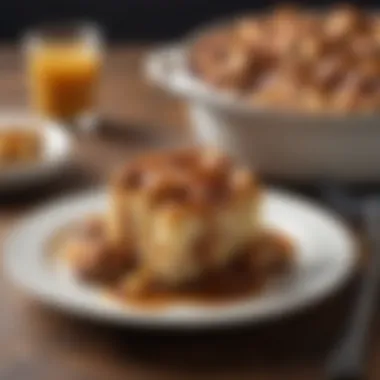
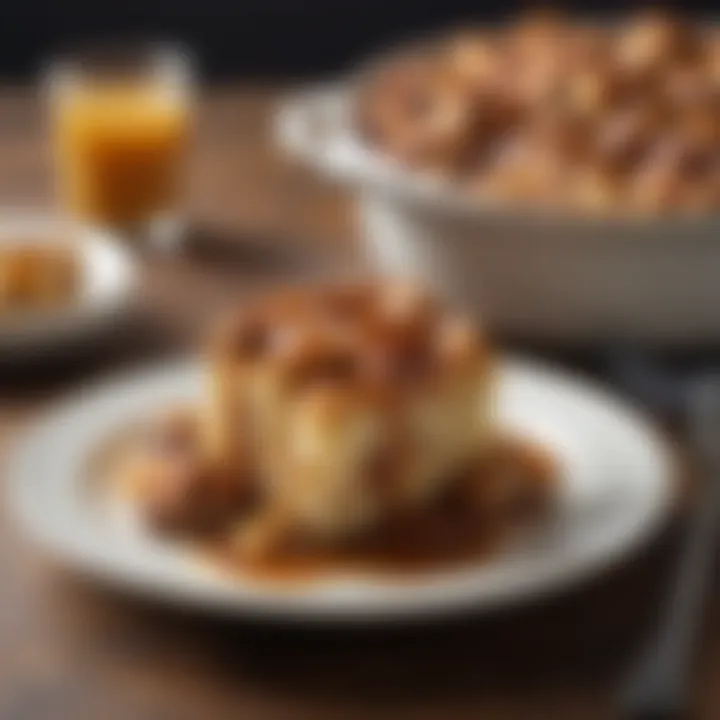
Intro
Bread pudding is not just a dessert; it’s a comforting embrace in culinary form, often evoking memories of home and family gatherings. This timeless classic brings together remnants of bread that might otherwise go to waste, transforming them into a rich custard-filled delight. Packed with flavor yet refreshingly simple, bread pudding serves as both a palette for creativity and a canvas for tradition.
This guide delves into the intricate art of crafting a basic bread pudding, covering everything from choosing the right ingredients to exploring variations that suit diverse palates. Whether you're a seasoned baker or a busy individual looking to whip something up without spending hours in the kitchen, this comprehensive resource has something for everyone.
Let’s embark on this delicious journey, ensuring that the next time you contemplate dessert, you’ll think of the versatility and satisfaction that bread pudding can bring to your table.
Understanding Bread Pudding
Bread pudding is more than just a dessert; it harks back to a simpler time when food waste was unthinkable. By transforming stale bread into a delightful dish, one taps into a culinary tradition that combines creativity and resourcefulness. In this article, we'll explore what makes bread pudding a beloved staple across cultures and generations. It's a dish that not only satisfies the sweet tooth but also captivates the heart and mind by its very essence of thrift and innovation.
Historical Context
The origins of bread pudding can be traced back to medieval Europe, a period when culinary practices were often driven by necessity. Resources were limited, and turning leftover bread into a sweet, comforting dessert was far more economical than tossing it away. Traditionally, recipes varied from region to region. For example, in England, the dish was enhanced with spices and fruits, while in France, chefs might incorporate cream and eggs to elevate its richness.
In the United States, the concept found new life, influenced by a delightful blend of European styles and local ingredients. Variations such as New Orleans bread pudding emerged, often featuring rich sauces and additions like bourbon.
Bread pudding is essentially a canvas; it's about taking what you have and creating something wonderful and satisfying.
Basic Elements of Bread Pudding
To craft the perfect bread pudding, one must grasp the basic elements that come together to create this dish. While it may seem simple at first glance, the balance and combination of components distinguish an average pudding from a truly exceptional one.
Key ingredients include:
- Bread: The type of bread plays a crucial role. Sturdier varieties, like brioche or challah, tend to yield a richer and more flavorful result, while sourdough can add a unique tang.
- Liquid: Milk, cream, or a combination thereof forms the custard base. The choice here will impact both the texture and flavor.
- Sweeteners: Commonly used sugars, like granulated sugar or brown sugar, not only sweeten but also contribute to caramelization during baking.
- Flavorings: Vanilla, cinnamon, or nutmeg can elevate the dish, adding depth and warmth.
- Eggs: Essential for binding the ingredients together, they enrich the mixture and create a custard-like texture when baked.
Understanding these elements, and how they interact during the preparation process, serves as a solid foundation for creating a variety of bread pudding recipes tailored to personal taste. This knowledge opens the door for creativity in the kitchen, empowering cooks to experiment without fear.
Choosing the Right Bread
Choosing the right bread is a crucial step in the journey toward crafting an exceptional bread pudding. Bread serves as the foundation of this dish, absorbing flavors, creating texture, and providing the overall structure. A well-selected bread not only enhances the pudding’s flavor but also determines its final texture. While bread puddings can be made from various types of bread, knowing what works best can make all the difference.
When considering which bread to use, think about the texture and flavor profiles you want to achieve. Some breads are denser and hold moisture better, while others might crumble and lose form. Fresh bread and stale bread also have their merits and demerits. Moreover, incorporating different types can lead to unique flavor combinations.
Types of Bread Suitable for Pudding
In the world of bread puddings, not all breads are created equal. Here are some key types that work particularly well:
- Challah: This slightly sweet, airy bread is traditional for bread pudding and provides a soft, rich texture.
- Brioche: Similar to challah but richer, brioche brings a buttery flavor that transforms your pudding into a decadent treat.
- French Bread: Its crusty exterior and chewy texture make it a solid option; it soaks up custard beautifully.
- White Sandwich Bread: This is a versatile choice that readily adapts and soaks in flavors, making it a popular option in many kitchens.
- Whole Wheat Bread: Adds a nutty flavor and rustic texture, offering a heartier pudding experience.
- Crusty Artisan Loaves: These can add complex flavor profiles and a crunchy texture that balances the softness of the custard.
Remember, the best bread for your pudding depends on the taste and texture you prefer. Experimenting with different varieties can lead to delightful surprises.
Stale Bread: A Practical Choice
Using stale bread may seem odd, but it can actually be a game-changer in the world of bread pudding. Stale bread is denser and has less moisture, allowing it to soak up the custard mixture without falling apart. Especially for those who are mindful about food waste, stale bread serves as a brilliant solution for transforming leftovers into a delightful dessert.
"The beauty of stale bread is that it’s akin to a blank canvas. It eagerly absorbs flavors and turns them into something warm and satisfying."
Moreover, stale bread typically has a more developed flavor, which can enhance the overall taste of your pudding. If you've got a loaf sitting on your counter that’s been neglected – don't toss it! Instead, toss it into your next bread pudding, turning what could be waste into a delicious dish.
Core Ingredients
Understanding the core ingredients is fundamental when it comes to making a bread pudding that can't help but delight your taste buds. Each plays a specific role in shaping the overall flavor, texture, and consistency of the dish. Let’s peel back the layers and examine why these ingredients are not just mere components, but the backbone of this comforting dessert.
Essential Liquid Components
The liquid components in a bread pudding recipe are crucial, serving to both infuse flavor and ensure a moist and cohesive final product. The most common liquids used are milk and cream, each bringing its own unique qualities to the mix. For instance, milk provides a lighter base, while cream takes richness to another level. You might consider using a combination of both to strike the right balance.
But the surprises don’t end there! Many bakers opt to spice up their mixtures with added elements like vanilla extract or even a dash of bourbon or rum. These additions can elevate the flavor profile immensely, lending a subtle warmth that draws you in for more. You can also play around with non-dairy options if you have dietary preferences. Almond milk, coconut milk, or even oat milk can be fantastic alternatives without sacrificing too much in terms of richness or creaminess.
Understanding Sugars and Flavorings
When it comes to sweetness, you don’t want to just throw in any old sugar and call it a day. The type of sugar you choose can have a dramatic impact on the flavor of your bread pudding. Granulated sugar is the go-to, but if you're on the lookout for something richer, brown sugar might be the ticket. Its molasses content lends a deep, caramel-like quality that will give a whole new dimension to your dish.
This is where your personal touch can shine. Try adding in flavorings such as cinnamon or nutmeg—these spices not only provide warmth but can also whisk you down memory lane with their nostalgic scents. For more adventurous souls, experimenting with flavored syrups or honey can take your pudding to new heights, infusing it with delightful nuances.
Choosing the Right Eggs
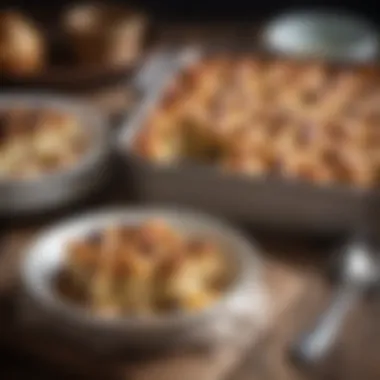
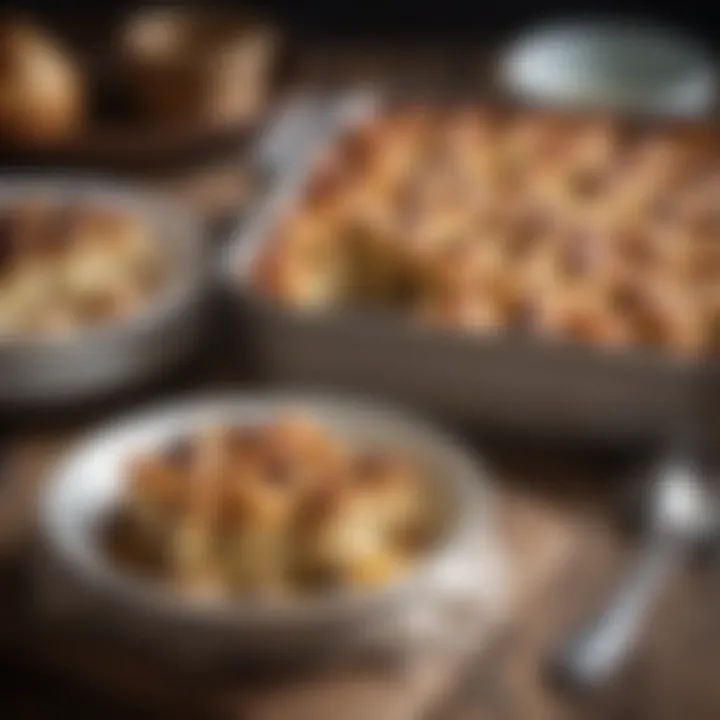
Eggs are essentially the glue that holds your bread pudding together. They provide structure and help create that custardy texture that everyone adores. Freshness matters here; using high-quality eggs from free-range chickens or organic sources will make a noticeable difference in flavor. The richer yolks will contribute to a deeper color and a more luxurious taste.
And while most people use whole eggs, some bakers swear by using just the egg yolks for an even creamier texture. However, using a balance of both can yield a wonderfully enriching result. It’s also wise to consider how many eggs you might need, as it usually depends on the amount of liquid and bread used in the recipe.
Thus, selecting the right eggs is not merely about function but about enhancing the overall quality of your dish.
"The ingredients you choose are the brushstrokes that create your culinary masterpiece. Take the time to pick wisely."
Preparing the Mixture
When it comes to crafting an exquisite bread pudding, the mixture stage is where the magic truly happens. This phase combines the elements that create the pudding’s very essence, impacting not only flavor but also texture. Preparing this mixture properly lays the groundwork for a dessert that is not just palatable but also memorable. The tender balance of moisture and ingredients is crucial. Fail in this stage, and you risk ending up with a soggy or overly dry bake—neither of which does justice to the humble beauty of bread pudding.
The Importance of Soaking Bread
Soaking the bread might seem like a simple step, but it's fundamentally vital. When bread is soaked in liquid—commonly a mixture of milk and eggs—it absorbs the moisture, leading to a rich and creamy texture. This absorption is particularly important for stale bread, which, by nature, is drier. Think of the bread as a sponge. If you don’t soak it long enough, the result can be a grainy, uneven pudding that disappoints at first bite.
The soaking duration can vary, typically ranging from 15 to 30 minutes. However, monitoring the consistency is crucial. A well-soaked bread should feel soft yet not overly mushy; it needs to maintain some structure. This is where experience is key. If the bread sops up enough of the liquid without losing its form, it sets the stage for a pudding that is both flavorsome and indulgently creamy.
"A good soak transforms your bread from mere sustenance to a luxurious dessert canvas."
Mixing Techniques for Optimal Texture
Once the soaking period is over, the next step involves blending the soaked bread with the remaining ingredients. This step is where attention to detail comes into play. The technique you choose can significantly impact the final texture of your bread pudding.
Start by gently breaking apart the soaked bread. Use your hands or a spatula, ensuring the pieces are small enough to combine seamlessly with the other ingredients. However, refrain from overmixing, as this can lead to a gummy consistency. It’s a delicate dance; you want to combine everything well but not to the point that the bread falls apart completely.
When combining the mixture, the incorporation of sugar, spices, and any additional flavorings should be done gradually. This allows for a uniform distribution of flavors throughout the pudding. Each ingredient needs the chance to meld with the soaked bread, ensuring that every bite delivers a burst of delightful taste.
Incorporate everything to the extent that the liquids and solids are harmoniously mingled. A light hand here can produce a pudding that is rich yet light in texture, an inviting treat for any dessert lover.
Ultimately, the method of preparing the mixture can transform your bread pudding from a basic recipe to a culinary delight that even the most discerning palate would find irresistible.
Baking the Bread Pudding
Baking bread pudding is where the magic really happens. Once you've carefully combined your ingredients and allowed the bread to soak up all those flavors, popping it in the oven transforms everything into a luxurious dessert. The act of baking not only solidifies the pudding’s structure but also enhances its taste, elevating it from a simple mixture to a rich and comforting dish. The aroma that wafts through the kitchen as it bakes is enough to draw anyone in, instantly creating a sense of warmth and nostalgia.
This step demands attention to a few key elements to ensure perfection. First and foremost, the right bakeware plays a crucial role in how evenly your pudding cooks. Different materials conduct heat differently; glass bakeware tends to hold heat while metal allows for a quicker bake. Choosing how to bake your pudding can therefore affect the final texture and flavor.
Secondly, understanding optimal baking temperature and time is critical. An incorrect temperature can lead to a pudding that is overcooked on the outside but still runny in the middle, or, conversely, an undercooked mess. In this guide, we'll break down the specifics of selecting the right bakeware and the ideal conditions for baking to help you master this classic dessert.
Selecting the Right Bakeware
When it comes to selecting bakeware for bread pudding, several options stand out. While you might think any old dish will do, choosing the right container can make a world of difference.
- Glass Baking Dishes: These allow for even heating and let you keep an eye on the pudding’s progress, which can be crucial. A clear view of the pudding can help you discern when it’s just set and ready.
- Ceramic Bakeware: Renowned for its ability to maintain temperature, ceramic can create a beautifully browned top while cooking the center evenly. Just be aware that it often takes longer to heat up precisely.
- Metal Pans: These heat quickly and are great for achieving a crispy top, but they can lead to uneven cooking if not monitored closely. Using a dark-colored pan could speed up the cooking process even more.
In all scenarios, ensure that whatever you choose has enough depth to accommodate the bread pudding mixture without risking overflow.
Optimal Baking Temperature and Time
Setting the right temperature is akin to setting the stage for a show. Most bread pudding recipes recommend a baking temperature of 350°F (175°C), which provides a perfect balance between cooking through and browning on top. This moderate heat allows the mixture to set properly without burning the edges.
In terms of timing, a good rule of thumb is about 40 to 50 minutes for a standard recipe, though this can vary based on the size and thickness of your pudding. To check for doneness, insert a knife into the center. If it comes out clean, your pudding is ready.
Don’t forget that some ovens can be temperamental. A quick peek is sometimes all it takes – just don’t open that oven door too often, or you'll let out all that precious heat! Remember to utilize a toothpick or a skewer for a more reliable test on whether your bread pudding is set or needs a little more time in the oven.
A well-baked bread pudding should be puffed up, golden brown on top, and just set—this is your indicator of success.
By choosing the right bakeware and paying attention to the temperature and time, you can ensure your bread pudding comes out perfect every time.
Customizing Your Recipe
Creating bread pudding is a craft where personal touches can shine, turning a classic dish into a reflection of individual taste. Customizing your recipe is key for several reasons. Firstly, this flexibility enables the cook to cater the dish according to seasonal ingredients or personal preferences. Secondly, adding diverse flavors not only enhances the overall experience but also creates a unique signature dish that can become a favorite within family gatherings or dinner parties.
When it comes to putting your spin on bread pudding, the sky is the limit. Don’t be afraid to experiment with various components, whether it's incorporating fruits, nuts, or spices. Let’s take a closer look at two ways you can make your version stand out:
Incorporating Fruits and Nuts
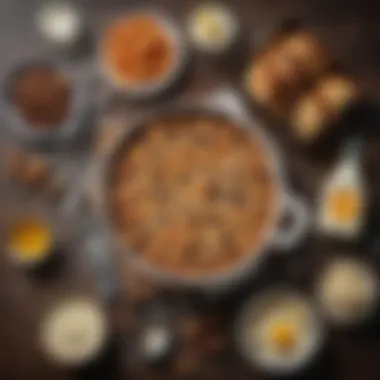

Fruits and nuts can add texture and flavor that elevate your bread pudding from simple to sublime. For example, adding chopped apples or pears brings natural sweetness and moisture, while berries bring a tangy burst. You can even opt for dried fruits like raisins or craisins, which provide a chewy contrast to the soft pudding structure.
Here are some popular combinations to consider:
- Apples and Cinnamon: A classic choice that works especially well during the fall. The warmth of the cinnamon complements the tenderness of baked apples beautifully.
- Bananas and Walnuts: This combination lends itself to a moist and rich texture, offering a taste that feels almost indulgent.
- Cherries and Almonds: Tart cherries mixed with the nutty crunch of almonds can create a delightful twist that surprises the palate.
Incorporating these elements is straightforward: simply fold them into your soaked bread mixture before baking. Adjust the quantities based on your preference and the desired flavor intensity.
Exploring Spice Options
Spices are the unsung heroes of many kitchens, capable of transforming ordinary dishes into the extraordinary. In bread pudding, spices allow chefs to create layered flavors. Think beyond the usual nutmeg and vanilla. Here are some options:
- Nutmeg and Cloves: A pinch of ground nutmeg paired with cloves will impart a warm, aromatic quality that is deeply satisfying.
- Cardamom or Ginger: For a more exotic flair, consider adding cardamom or ground ginger. These spices introduce characteristic warmth that can make each bite memorable.
- Cocoa Powder: For chocolate lovers, incorporating cocoa powder can add a rich, decadent layer without overshadowing the core ingredients.
To keep things user-friendly, start with a small measure of your chosen spices, gradually adjusting to find the perfect balance for your palate. A dash of this or that can work wonders, but too much can easily overwhelm, so proceed with caution!
Tip: Keep a journal of your flavors and combinations. You'll quickly discover what works and what falls flat, helping you refine your recipe over time.
In summary, customizing your bread pudding recipe is an opportunity to reflect various flavors and create a dish that is distinctive to your taste. Embrace this culinary canvas, and don't shy away from playing with fruits, nuts, and spices to make it your own.
Serving Suggestions
Serving suggestions play a pivotal role in elevating the experience of enjoying bread pudding. Here, we explore how thoughtful additions can enhance flavors and aesthetics, making your dessert not just a simple dish but a feast for both the eyes and taste buds.
Pairing with Sauces and Dressings
The choice of sauces and dressings can turn a basic bread pudding into a culinary masterpiece. A well-paired sauce can complement the dessert’s texture and flavor profile while providing a delightful contrast. Think about rich flavors like vanilla custard or chocolate sauce. These options can add a creamy contrast to the soft, fluffy texture of the bread pudding.
Here are some popular sauces to consider:
- Caramel Sauce: Its deep, sweet flavor creates a wonderful balance with the richness of the pudding.
- Berry Compote: Fresh or cooked berries can add a tartness that lightens the dessert.
- Whipped Cream: For a lighter touch, a dollop of freshly whipped cream can make each bite feel more luxurious.
When serving, it’s effective to offer a selection of sauces for guests to drizzle over their pudding. This not only gives them the freedom to tailor their own dessert but also encourages engagement at the table.
Garnishing for Presentation
Presentation is the cherry on top of any dish, and bread pudding is no exception. Simple garnishes can increase the elegance of your serving, turning a humble dessert into something quite grand. They can also enhance the sensory experience—both visually and flavor-wise.
Consider these garnishing ideas:
- Fresh Mint Leaves: A few mint leaves add color and a refreshing flavor.
- Powdered Sugar: Dusting powdered sugar lightly over the top gives a touch of sweetness that’s also visually appealing.
- Nuts: Toasted pecans or walnuts can provide a lovely crunch, complementing the soft texture of the pudding.
A well-garnished bread pudding can transform the meal into a true show-stopper, demonstrating attention to detail and care in preparation.
"An eye-catching presentation lays the groundwork for an enjoyable meal experience. Always remember that we eat with our eyes first."
In choice and arrangement, every element plays its part in the overall serving of bread pudding. By pairing wisely and garnishing, you can create a memorable dessert that leaves a lasting impression.
Storage and Reheating Tips
Bread pudding is a dessert that brings comfort and satisfaction, yet part of this dish’s charm lies in its potential for leftovers. Knowing how to properly store and reheat your bread pudding can greatly enhance its longevity and maintain its delightful taste and texture. Here, we’ll dive into ideal storage conditions and reheating techniques, helping you relish this treat beyond its initial serving.
Ideal Storage Conditions
Storing your bread pudding in the correct manner is imperative to preserving its rich flavors and moist texture. Here are some important considerations for storage:
- Cool Before Storing: Allow your bread pudding to cool completely at room temperature before you think about putting it away. Storing it warm can create excess moisture that leads to sogginess.
- Use Airtight Containers: Select a container that seals tightly. This helps limit air exposure, preventing the dessert from drying out or absorbing unwanted odors from other foods in the fridge. Choose containers that fit your pudding snugly to minimize the amount of air inside.
- Refrigerate for Short Term: If you plan on enjoying your leftover bread pudding within a week, it’s best stored in the refrigerator. It can last about 3 to 5 days in there, maintaining its integrity if properly sealed.
- Freeze for Longevity: Freezing is an excellent option if you’re looking to save your bread pudding for longer periods. Wrap individual slices tightly in cling film and then store them in a freezer-safe bag or container. When done this way, it can last up to two months.
Ensure you label your containers or bags with the date. This little step will keep you on track and ensure you consume your leftovers while they’re still at their best.
Proper Reheating Techniques
Reheating bread pudding can be delicate work. You want to preserve the moist goodness without overcooking it. Here are some techniques that can help:
- Oven Reheating: The oven is a reliable choice for reheating. Preheat your oven to 350°F (175°C) and place your bread pudding in an oven-safe dish. Cover it loosely with aluminum foil to keep moisture in and avoid drying it out. Heat for about 15 to 20 minutes, or until it's warmed through. You can remove the foil in the last few minutes for a slightly crisp top, if desired.
- Microwave for Quick Fixes: If you’re short on time, use the microwave but proceed with caution. Cut a portion of bread pudding and place it on a microwave-safe plate. Add a splash of milk or a dab of butter on top to maintain moisture. Heat it in short intervals of 15 to 30 seconds, checking frequently to ensure it doesn’t become rubbery.
- Steaming Method: For those looking to keep their pudding exceptionally moist, steaming is an alternative method. Place your pudding in a steaming basket over a pot of simmering water, cover, and steam for about 10 to 15 minutes.
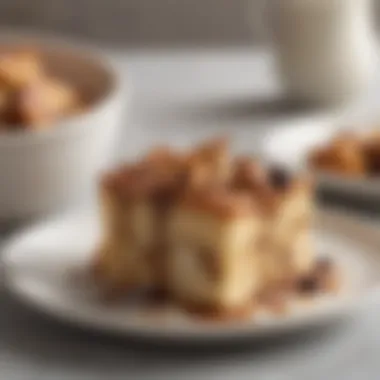
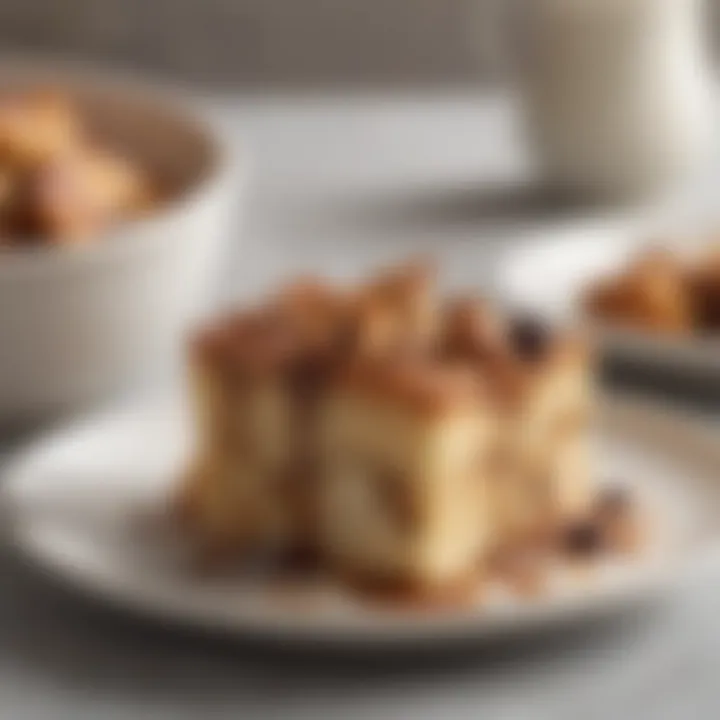
These storage and reheating practices not only help prolong the life of your bread pudding but also ensure that it remains tasty. Proper care can make this delicious dessert an enduring part of your culinary repertoire.
Nutritional Considerations
Understanding the nutritional aspects of bread pudding goes a long way in enhancing both the enjoyment and the health impact of this classic dessert. While it is easy to chalk up bread pudding as nothing more than a sweet indulgence, digging deeper reveals it can be a potentially balanced dish, especially when mindful ingredient choices are made. Knowing the calorie count and considering healthier alternatives can make a world of difference in your culinary journey.
Analyzing Caloric Content
When prepping a bread pudding, one might not immediately think about the calories stacked up in a serving. However, being aware of caloric content is crucial, particularly for those who have dietary goals or restrictions. Traditional bread pudding includes various components such as bread, eggs, milk, sugar, and often additional enrichments like butter or cream.
For instance, a standard serving could easily hit 300 to 400 calories, depending on portion size and types of ingredients used. Let’s break it down:
- Bread: Ranges from about 70 to 100 calories per slice, depending on the type.
- Eggs: Typically around 70 calories each.
- Milk: Whole milk has about 150 calories in a cup, while skim will be lower.
- Sugar: Each tablespoon contains about 50 calories, and bread pudding can have several tablespoons based on sweetness preference.
So, a rich, creamy bread pudding could come with a caloric punch that's hard to ignore.
"A well-informed cook is half way to a delicious dessert."
Alternative Ingredients for Healthier Options
Fortunately, you don't have to sacrifice flavor for healthier choices. As culinary enthusiast, considering alternative ingredients could not only reduce kcal but also enhance nutritional value. Here are a few smart swaps you might find beneficial:
- Use Whole Grain Bread: Opting for whole-grain bread enhances fiber content, making it a more filling option, and could lower the glycemic index.
- Lower the Sugar: Explore natural sweeteners, like honey or maple syrup, which can offer a unique flavor profile while potentially lowering calories.
- Dairy Alternatives: Almond milk or coconut milk can be a lighter substitute, reducing both calories and lactose for sensitive individuals.
- Egg Replacements: Consider using chia seeds or applesauce to cut down on cholesterol and further reduce calories.
- Incorporate Fruit: Adding fruits like berries or apples not only boosts flavor but also adds essential vitamins and antioxidants.
By making these substitutions, you can savor your bread pudding with a lighter conscience, knowing that it can fit into a more balanced diet.
Frequently Asked Questions
This section aims to address some common inquiries that arise when exploring the delightful world of bread pudding. A dish that invites creativity, understanding its various facets can enhance both the cooking process and the final flavor. Bread pudding has earned its place not only on dessert menus but also in the hearts of dedicated home cooks. Knowing the ins and outs can make all the difference in enjoying or even mastering this delicious dessert.
Can Make Bread Pudding Ahead of Time?
Certainly! One of the beauties of bread pudding is its versatility, especially when it comes to preparation. Making bread pudding ahead of time can actually improve its flavor. Once mixed, allowing it to sit for a few hours or overnight gives the bread ample time to soak up the custard mixture, leading to a richer taste. When you prepare it in advance, you also free up your kitchen on the day you wish to serve it.
To do this, follow these steps:
- Prepare the custard and mix ins: Whip together your eggs, milk, sugar, and any spices or flavorings you fancy.
- Combine with the bread: Stir bread pieces into the custard until well coated.
- Chill and store: Transfer the mixture to your baking dish, cover tightly, and place it in the fridge.
When you’re ready to bake, simply remove it from the fridge, allow it to come to room temperature for about 30 minutes, and then proceed to bake as usual. This approach makes it easy to serve during special occasions or busy weekdays.
What Can Substitute for Eggs?
For those who are vegan or have dietary restrictions, it’s entirely possible to make a delicious bread pudding without using eggs. There are several effective substitutes that not only mimic the texture of eggs but also add distinct flavors to the dish. Here are a few popular options:
- Flaxseed Meal: Mix 1 tablespoon of flaxseed meal with 2.5 tablespoons of water and let it sit for about 5 minutes until it thickens. This mimics the binding properties of eggs very well.
- Aquafaba: The liquid from a can of chickpeas can replace eggs at a ratio of about 3 tablespoons of aquafaba per egg.
- Silken Tofu: Blend 1/4 cup of silken tofu until smooth. This works well, providing a creamy texture with neutral flavoring.
- Applesauce: A 1/4 cup of unsweetened applesauce can be used in place of one egg. It adds a touch of sweetness and moisture.
Keep in mind that when using these alternatives, the final result may have subtle variations in taste and texture. Experimenting with different substitutions can lead to exciting discoveries, enhancing your bread pudding repertoire.
"Bread pudding is as forgiving as it is delicious; the key is to embrace your personal preferences."
By addressing these common questions, we not only provide clarity for potential bakers but also encourage a broader understanding of how bread pudding can fit into various culinary lifestyles.
The End
Bread pudding, a cherished dessert, holds a special place in many kitchens. This conclusion serves to emphasize the importance of the elements discussed throughout the article, along with the benefits that making bread pudding can bring to your culinary repertoire.
Recap of Key Points
To effectively reflect on what we've explored, here are the key components to remember when crafting your bread pudding:
- Choosing the Right Bread: Not all bread is created equal. Stale or day-old bread enhances texture and flavor.
- Core Ingredients: The combination of eggs, milk, and a mix of sugars creates the custard base that defines bread pudding.
- Preparation Techniques: Proper soaking of the bread ensures it absorbs the liquid evenly, leading to a moist and flavorful pudding.
- Baking Considerations: Pay attention to bakeware and temperature; both have a significant influence on doneness and texture.
- Customization Options: Remember, the beauty of bread pudding lies in its versatility. Adding fruits, nuts, and spices can elevate your dish.
By keeping these points in mind, you equip yourself with the knowledge necessary for crafting a delightful bread pudding that marries simplicity with flavor.
Encouragement to Experiment
As we’ve discussed, bread pudding is not just a dish—it's a canvas for culinary creativity. Don't shy away from adding your twist to the recipe. Try incorporating dried cranberries or pecans for an interesting flavor profile. Perhaps a touch of maple syrup or a sprinkle of cinnamon could take your dessert to the next level. The key is to remember that the essence of bread pudding lies in its adaptability.
With each bake, consider what flavors resonate with you. Maybe you prefer a hint of orange zest or a layer of dark chocolate. All these variations invite the cook to play around with textures and flavors.
"Cooking is like love. It should be entered into with abandon or not at all."
—Harriet Van Horne
So, don't be afraid to roll up your sleeves. Experiment with what you have on hand! The final product should reflect your taste and preferences. Who knows? You may just stumble upon your own signature bread pudding recipe that you'll cherish for years to come.







